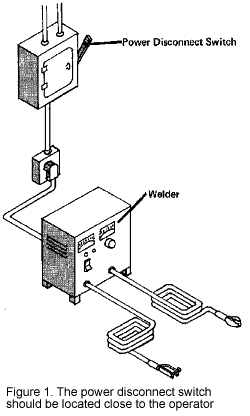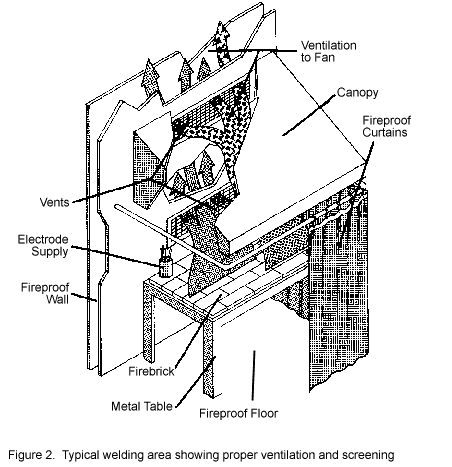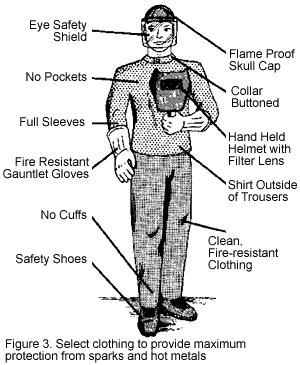INTRODUCTION
The
electric arc welder remains one of our most useful and timesaving
pieces of shop equipment. Almost every farm, ranch, and Vocational
Agriculture shop is equipped with one or more welders which
are used for fabrication, repair, and/or educational programs.
Most of these welders are typically AC/DC, 240 volt transformer
types using electricity as the energy source. Portable welders
are of the diesel/gasoline engine powered type. Properly installed
and used the arc welder is very safe, but if used improperly
the operator can be exposed to a number of hazards including
toxic fumes, dusts, burns, fires, explosions, electric shock,
radiation, noise, and heat stress. Any of these hazards can
cause injury or death. By following suggestions and guidelines
in this pamphlet the risks can be greatly minimized.
SELECTING THE ARC WELDER
INSTALLING THE ARC WELDER
 Prior to installing the arc welder you should determine if your
present electrical system is adequate to handle the increased
load required by the welder. Your local power supplier or
a qualified electrician can assist you in determining this.
It is very important for your safety to install the welder in
compliance with State of Arizona, Occupational Safety and Health
Administration (AOSHA) regulations and the National Electric
Code (NEC) by a qualified electrician. Failure to do so could
cause fire, a ground fault, or equipment failure. The following
rules are not a complete list but are especially important guidelines which
should be adhered to:
Prior to installing the arc welder you should determine if your
present electrical system is adequate to handle the increased
load required by the welder. Your local power supplier or
a qualified electrician can assist you in determining this.
It is very important for your safety to install the welder in
compliance with State of Arizona, Occupational Safety and Health
Administration (AOSHA) regulations and the National Electric
Code (NEC) by a qualified electrician. Failure to do so could
cause fire, a ground fault, or equipment failure. The following
rules are not a complete list but are especially important guidelines which
should be adhered to:
VENTILATION

FIRE PREVENTION
Suitable fire extinguishing equipment such as buckets of sand or a dry chemical extinguisher of the ABC type should be readily available. The extinguisher should be large enough for the situation with a 10# size adequate for most farm and school shops.
PERSONAL PROTECTION
 It is essential that the operator and helpers be properly clothed
and protected because of the heat, ultra-violet rays, and sparks,
produced by the arc welder (See Figure 3). For body protection
a pair of fire retardant long sleeved coveralls without cuffs
is a good choice. Always avoid clothing with tears, snags, rips,
or worn spots as these are easily ignited by sparks. The sleeves
and collars should be kept buttoned. The hands should be protected
with leather gauntlet gloves. A pair o high top leather shoes,
preferably safety shoes, is good protection for the feet. If
low shoes are worn the ankles should be protected by fire resistant
leggings. Eyes should be protected by transparent goggles if
the person wears prescription glasses or safety glasses if not.
A welding helmet or hand shield with filter plate and cover
plate is mandatory for eye protection from the harmful rays
of the arc. The filter plate should be at least shade #10 for
general welding up to 200 amps. However, certain operations
such as carbon-arc welding and higher current welding operations
require darker shades. Never use a helmet if the filter plate
or cover lens is cracked or broken. A flame-proof skull cap
to protect the hair and head as well as hearing protection in
noisy situations is recommended.
It is essential that the operator and helpers be properly clothed
and protected because of the heat, ultra-violet rays, and sparks,
produced by the arc welder (See Figure 3). For body protection
a pair of fire retardant long sleeved coveralls without cuffs
is a good choice. Always avoid clothing with tears, snags, rips,
or worn spots as these are easily ignited by sparks. The sleeves
and collars should be kept buttoned. The hands should be protected
with leather gauntlet gloves. A pair o high top leather shoes,
preferably safety shoes, is good protection for the feet. If
low shoes are worn the ankles should be protected by fire resistant
leggings. Eyes should be protected by transparent goggles if
the person wears prescription glasses or safety glasses if not.
A welding helmet or hand shield with filter plate and cover
plate is mandatory for eye protection from the harmful rays
of the arc. The filter plate should be at least shade #10 for
general welding up to 200 amps. However, certain operations
such as carbon-arc welding and higher current welding operations
require darker shades. Never use a helmet if the filter plate
or cover lens is cracked or broken. A flame-proof skull cap
to protect the hair and head as well as hearing protection in
noisy situations is recommended.
Plastic disposable cigarette lighters are very dangerous around heat and flame. It is very important that they not be carried in the pockets while welding. Always provide protection to bystanders or other workers by welding inside a properly screened area, if possible. If unable to work inside a screened area then protection to others should be provided by a portable screen or shield, or by their wearing anti-flash goggles.
SAFE OPERATION OF THE WELDER
Because of their potentially explosive nature, we strongly recommend that no welding, cutting, or hot work be attempted on used drums, barrels, tanks, or other containers under any circumstances.
If possible, work to be welded should be placed on a firebrick surface at a comfortable height. Welding should never be done directly on a concrete floor. Heat from the arc can cause steam to build-up in the floor which could cause an explosion. The welder cables should be positioned so that sparks and molten metal will not fall on them. They should also be kept free of grease and oil and located where they will not be driven over.
Electric welders can kill by electric shock. If the welding operation must be done on steel or other conductive material an insulating mat must be used under the operator. If the welding area is wet or damp or the operator is actively perspiring then he/she should wear rubber gloves under the welding gloves.
It is easier and safer to establish an arc on a clean surface than a dirty or rusty one. Therefore, metal should always be thoroughly cleaned by wire brushing or other method prior to welding. When chipping slag or wire brushing the finished bead the operator should always be sure to protect his eyes and body from flying slag and chips. Unused electrodes and electrode stubs should not be left on the floor as they create a slipping hazard. Hot metal should be handled with metal tongs or pliers. When quenching hot metal in water it should be done carefully to prevent painful burns from the escaping steam. Any metal left to cool should be carefully marked "HOT" with a soapstone. When welding is finished for the day or suspended for any length of time electrodes should be removed from the holder. The holder should be placed where no accidental contact could occur, and the welder should be disconnected from the power source.
SAFETY PRECAUTIONS FOR ENGINE POWERED WELDERS
FIRST AID
KEY POINTS TO REMEMBER
Publication #: 8818
This document is apart of a series from the Cooperative Extension, the University of Arizona, Tucson, AZ 85719. Publication date: May 1989.
Lance Fluegel, Safety Coordinator and Bradley Rein, Engineering Specialist, the College of Agriculture, the University of Arizona, Tucson AZ 85719.
Disclaimer and Reproduction Information: Information in NASD does not represent NIOSH policy. Information included in NASD appears by permission of the author and/or copyright holder. More